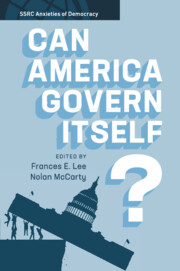Book contents
- Can America Govern Itself?
- SSRC Anxieties of Democracy
- Sponsored by the Social Science Research Council
- Can America Govern Itself?
- Copyright page
- Contents
- Acknowledgments
- 1 The Anxieties of American Democracy
- Part I Anxieties of Power, Influence, and Representation
- Part II Procedural Anxieties
- Part III Anxieties of Governance
- 10 Public Policy and Political Dysfunction
- 11 The Effects of Partisan Polarization on the Bureaucracy
- 12 Polarization and the Changing American Constitutional System
- 13 Democratic Anxieties
- Index
- Index Authors
- References
12 - Polarization and the Changing American Constitutional System
from Part III - Anxieties of Governance
Published online by Cambridge University Press: 25 May 2019
- Can America Govern Itself?
- SSRC Anxieties of Democracy
- Sponsored by the Social Science Research Council
- Can America Govern Itself?
- Copyright page
- Contents
- Acknowledgments
- 1 The Anxieties of American Democracy
- Part I Anxieties of Power, Influence, and Representation
- Part II Procedural Anxieties
- Part III Anxieties of Governance
- 10 Public Policy and Political Dysfunction
- 11 The Effects of Partisan Polarization on the Bureaucracy
- 12 Polarization and the Changing American Constitutional System
- 13 Democratic Anxieties
- Index
- Index Authors
- References
Summary
Concerns about the onsequences of polarization arise from the belief that Congress is not designed to perform well in polarized environments. But the implications of reduced legislative capacity on the American constitutional system have received far less attention. Thus important questions are unanswered. How have the other branches responded to the decline in legislative capacity occasioned by increased polarization? Have other branches expanded their power at Congress’s expense? This chapter makes two arguments. First, legislative dysfunction reduces the contribution of Congress to good policymaking. While this impact may be offset by a more assertive exercise of executive or judicial power, the central role of Congress in the constitutional system leads to a decline in the quality of governance. Second, declining legislative capacity affects the relative influence on Congress over outcomes. The decline in the ability of Congress to reach decisions allows more room for other constitutional actors to act without legislative constraint.These two effects suggest that legislative dysfunction affects the balance of constitutional authority in both absolute and relative terms.
- Type
- Chapter
- Information
- Can America Govern Itself? , pp. 301 - 328Publisher: Cambridge University PressPrint publication year: 2019

